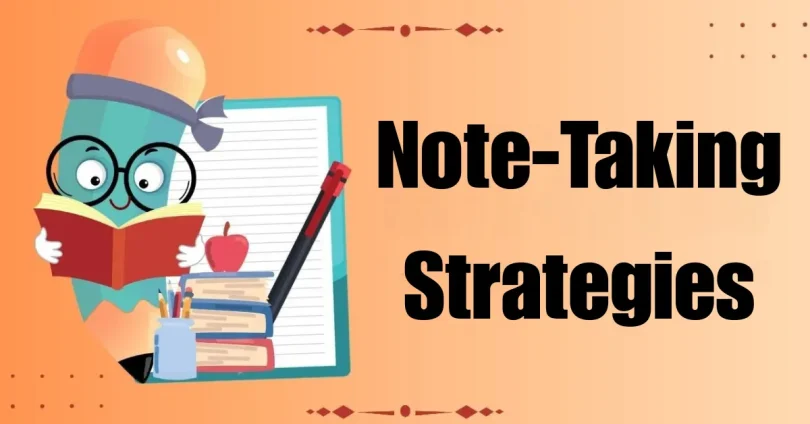We’ve all been there—standing at the front of the class, delivering a lecture packed with valuable insights, only to see students barely lift a pencil. In today’s tech-centric education system, learners often expect handouts, digital class notes, and web-based study materials.
However, even with all these conveniences, the fundamental practice of taking notes by hand—or using effective digital tools—remains irreplaceable. Note-taking strategies are not just about jotting down words; they are about learning to process, organize, and retain knowledge in a meaningful way.
Why Note-Taking Is Still Essential in the Digital Age

While students today have more access to resources than ever before, many still struggle with retention and understanding. Why? Because passive consumption of material doesn’t translate to active learning. This is where note-taking comes into play.
Taking notes isn’t merely recording what is said in class. It’s an active process that involves listening, understanding, and summarizing. Research suggests that students who take notes—especially by hand—tend to remember the information longer and perform better in exams compared to those who don’t. Effective note-taking strategies lead to better comprehension, deeper engagement with the material, and the ability to recall key information when it matters most.
Moreover, notes serve as personal study guides. When prepared using smart strategies, notes can help learners revise faster, prepare for tests more effectively, and understand complex topics with greater clarity.
You may also like to read this:
Create An Effective Study Schedule Planner For Results
10 Memory Improvement Tips For Students To Remember More
Latest Education Updates – What’s Changing In 2025
2025 School And College News: What’s New In Education
Top Global Education Policy Changes Reshaping Learning Today
Best Note-Taking Strategies Students Should Learn

Every student learns differently, which is why there are several note-taking strategies designed to fit various learning styles. Below is a breakdown of the most effective methods that learners should try:
1. The Cornell Method
The Cornell Method is one of the most popular and effective note-taking techniques, especially designed to help students condense, organize, and review their notes in a structured manner. It promotes active learning and retention through a system of summarization and self-reflection.
🔹 How It Works:
- Divide the page into three sections:
- A narrow left-hand column (cue column), where you will write keywords, questions, or main ideas after class.
- A wider right-hand column (note-taking area), where you take detailed notes during the lecture.
- A bottom section (summary), where you summarize the key points after class.
- A narrow left-hand column (cue column), where you will write keywords, questions, or main ideas after class.
- During the lecture, write detailed notes in the right-hand column.
- After the lecture, write keywords or questions in the left-hand column that summarize the main points. These cues will act as a guide for self-testing and reviewing.
- At the bottom, write a brief summary of the main concepts and ideas from the lecture.
✅ Why It Works:
The Cornell Method promotes active review and engagement with the material, which is key to improving retention and understanding. By splitting the page into sections for notes, cues, and summaries, students are encouraged to reflect on the material, review key points, and test their knowledge. This active process helps enhance memory retention and encourages deeper understanding of the material.
📚 Best For:
- Lectures and structured classes where content is delivered in a linear or sequential manner (e.g., history, math, or science).
- Students who prefer to organize their notes and reflect on the material after class.
2. The Outline Method
The Outline Method is one of the most logical and hierarchical ways to take notes. It helps students structure information in a way that clearly shows the relationship between main ideas and supporting details.
🔹 How It Works:
- Use headings for the main topics and subheadings for supporting ideas.
- Use indentation to show the hierarchy of information. The main points are on the top level, followed by sub-points, and further indentation for examples, explanations, or details.
- Organize the lecture or textbook material based on topics, subtopics, and related concepts using bullet points or numbering.
✅ Why It Works:
The Outline Method organizes information in a logical, easy-to-follow manner, making it easier to identify main ideas, supporting details, and relationships between concepts. This format is perfect for subjects where the material is structured and requires a hierarchical approach to understand relationships. The method helps students see how different pieces of information connect together, which is particularly useful for reviewing.
📚 Best For:
- Subjects that require a clear structure, such as history, literature, and science, where the material is often divided into categories and subcategories.
- Students who benefit from seeing concepts broken down logically for easier understanding and review.
3. The Mapping Method (Mind Mapping)
The Mapping Method (often called Mind Mapping) is a highly visual approach that connects ideas and concepts in a non-linear way, making it ideal for students who are visual learners or prefer to see relationships between ideas at a glance.
🔹 How It Works:
- Write the main topic in the center of the page.
- Branch out from the central idea with related subtopics or concepts, using lines, arrows, or branches to show how they are connected.
- Use symbols, images, and colors to make the relationships between ideas more visually clear.
- Continue branching out with further details or examples, creating a web of interconnected information.
✅ Why It Works:
The Mapping Method taps into the brain’s natural ability to process visual information, making complex or interconnected topics easier to understand. By using colors, shapes, and diagrams, students can visually map out how concepts relate to one another, which enhances recall and comprehension. This method also encourages creative thinking and can help in brainstorming and idea generation.
📚 Best For:
- Creative subjects such as art, psychology, or brainstorming sessions that involve interconnected ideas or concepts.
- Essay planning, where students need to visualize how different sections of the essay or argument relate to each other.
- Students who are visual learners and prefer to see concepts linked together in a spatial and dynamic way.
4. The Charting Method
The Charting Method is a structured way to organize data or information into columns and rows, making it especially useful for comparing and contrasting information. It’s a great method for handling data-heavy subjects where clear organization is necessary.
🔹 How It Works:
- Create a table or chart with columns for specific categories (e.g., date, event, cause, effect).
- As you take notes during the lecture, fill in the rows with the corresponding information related to each category.
- You can create multiple tables for different concepts or topics within the lecture, depending on how much data you need to organize.
✅ Why It Works:
This method is great for data-heavy subjects where comparison, organization, and pattern recognition are important. It allows students to quickly scan and identify key trends, relationships, or differences between categories of information. The chart format makes it easy to organize large amounts of data in a way that’s visually simple and effective for review.
📚 Best For:
- History, science, business, or any subject with large amounts of data, events, or comparative information.
- Students who need to compare and contrast different aspects of a topic (e.g., comparing historical events, biological processes, or economic theories).
5. The Sentence Method
The Sentence Method is one of the simplest ways to take notes, making it ideal for fast-paced lectures where students need to capture information quickly and efficiently.
🔹 How It Works:
- Write a new sentence for each key point or piece of information.
- Use numbers or bullets to separate each sentence or point.
- After the lecture, go back and highlight or underline key points that you want to emphasize or review later.
✅ Why It Works:
The Sentence Method is a fast, straightforward technique, allowing you to take detailed notes in real time without worrying too much about structure. It’s ideal for classes where the professor speaks quickly and you need to capture as much information as possible. After the lecture, you can go back and highlight important points or add clarifications. This method ensures you don’t miss key details.
📚 Best For:
- Fast-paced lectures like philosophy, literature, or sociology, where discussions and arguments evolve quickly and need to be captured in real time.
- Students who need speed and don’t have time to organize information as it’s presented.
6. The Boxing Method
The Boxing Method is an effective note-taking strategy for visual learners who prefer to process information in grouped formats. Rather than listing information linearly, this method involves dividing the page into distinct sections or “boxes,” with each one dedicated to a single topic or sub-topic.
🔹 How It Works:
- Begin by drawing boxes on your page—either pre-structured or as needed during the lecture.
- Label each box with a title that represents a specific topic or theme being discussed.
- As you learn or listen, write complete notes within each box that relate to that specific concept.
- When the topic changes, start a new box and continue.
✅ Why It Works:
This approach creates a visual separation of ideas, helping the brain associate grouped information more efficiently. It’s particularly helpful when reviewing or studying later, as each box acts as a mini-summary of an idea. With clearly segmented topics, scanning for specific concepts becomes faster and more intuitive.
📚 Best For:
- Visual learners
- Review or revision sessions
- Digital note-taking on tablets with styluses (like on GoodNotes or Notability)
7. Flow-Based Note-Taking (The Flow Method)
The Flow Method is an intuitive and flexible strategy that focuses less on structure and more on comprehension. Instead of simply recording what’s being said, this technique encourages students to engage with the material in real-time.
🔹 How It Works:
- Write notes in your own words as the lecture progresses.
- Use arrows, sketches, mind maps, or doodles to show relationships between concepts.
- Highlight your personal thoughts, questions, and connections alongside the core ideas.
- Avoid rigid formatting—let the notes “flow” as your mind understands the topic.
✅ Why It Works:
This method is especially effective for learners who want to deeply engage with the material instead of just passively recording it. By actively thinking about the content and rephrasing it, students are more likely to remember and understand it. The creative, free-flowing nature of this strategy makes it highly personalized.
📚 Best For:
- Creative learners
- Philosophy, humanities, psychology
- Slow-paced lectures where there’s time to reflect
8. Digital Note-Taking (Using Apps)
In today’s digital-first learning environment, many students are embracing digital note-taking strategies using apps like Notion, Evernote, OneNote, and Google Keep. These tools offer flexibility, multimedia integration, and easy organization.
🔹 How It Works:
- Choose your preferred note-taking app.
- Create digital notebooks and divide them into sections by subject or topic.
- Type notes during lectures or meetings.
- Insert images, audio recordings, PDF attachments, web links, and even handwritten input.
- Use features like tags, search bars, and cross-referencing to organize your content.
✅ Why It Works:
Digital tools offer searchable, editable, and shareable note systems. You can sync notes across devices and collaborate with classmates in real time. Additionally, multimedia support makes these notes far more dynamic than traditional pen-and-paper methods.
📚 Best For:
- Tech-savvy students
- Group projects and collaboration
- Remote and online learning
9. The Color-Coding Method
The Color-Coding Method is not so much a standalone method as it is a visual enhancement technique that can be paired with any of the previously discussed note-taking strategies.
🔹 How It Works:
- Assign specific colors to different categories of information—e.g. blue for dates, green for formulas, pink for definitions.
- Use colored pens, highlighters, or digital annotation tools.
- Be consistent in your color scheme to create mental associations.
- You can even use sticky notes or colored tabs for large printouts or books.
✅ Why It Works:
Colors help the brain quickly identify and categorize information. This leads to improved memory, especially for visual learners. During review time, your eyes can immediately jump to the most important parts of your notes.
📚 Best For:
- All subjects and learners
- Enhancing any core note-taking method
- Test preparation and summary reviews
10. Audio Note-Taking & Transcription
For students who are auditory learners—or those dealing with fast-paced lectures—recording audio and transcribing it later is one of the most practical note-taking strategies.
🔹 How It Works:
- Use a smartphone or dedicated voice recording app to capture lectures or discussions.
- After class, listen back and transcribe the most important parts.
- Alternatively, use tools like Otter.ai, Google Docs Voice Typing, or Descript to transcribe automatically.
- Combine the transcript with written summaries, highlights, or keyword tags.
✅ Why It Works:
It allows you to focus fully during the lecture without stressing over missing a point. Listening again helps reinforce learning, and transcription offers a searchable, editable version of the content for later review.
📚 Best For:
- Auditory learners
- Fast-paced or technical lectures
- Students with learning disabilities or physical writing limitations
11. The Split Page Method
The Split Page Method is a flexible strategy that combines the structure of the Cornell Method with more room for personal reflection and side-by-side comparison.
🔹 How It Works:
- Divide the page vertically into two equal sections.
- On the left side, take your standard lecture notes or record information from the textbook.
- On the right side, jot down your thoughts, reflections, summaries, and questions about the content you wrote on the left.
- After class, revisit the right-hand side to elaborate on any points or clarify concepts further.
✅ Why It Works:
This method encourages critical thinking as you engage with the material on a deeper level. It not only helps you record information but also prompts you to reflect on it, leading to improved comprehension and retention. By creating a dialogue between your notes and reflections, you are more likely to remember and understand the material.
📚 Best For:
- Reflective learners who enjoy thinking deeply about the material.
- Exam preparation or reviewing complex theories.
- Subjects like literature, philosophy, and social sciences where personal interpretation and critical analysis are key.
12. The Slide Note Method
The Slide Note Method is perfect for students attending digital classrooms or classes where instructors use PowerPoint slides or similar presentation tools.
🔹 How It Works:
- Before class, access the slides provided by your instructor.
- During class, annotate the slides directly with notes, additional context, or clarifications as the lecture unfolds.
- After the lecture, you can add extra readings, reflections, or questions next to the slides for further understanding.
✅ Why It Works:
This method reduces cognitive overload because the content is already visually organized by the instructor. By annotating directly on the slides, you keep everything related to that lecture in one place, making it easier to study and recall later. It also allows you to integrate multimedia such as images and charts directly into your notes.
📚 Best For:
- Visual learners who benefit from structured presentations.
- Students in PowerPoint-heavy courses like marketing, business, or science, where slides are often the main medium for information delivery.
- Digital or remote learning students who prefer having everything in a single, cohesive place.
13. Sketchnoting
Sketchnoting takes note-taking to the next level by blending visuals with words, providing a creative way to capture complex ideas. It’s a popular method for creative thinkers and visual learners.
🔹 How It Works:
- Rather than writing traditional notes, use drawings, icons, and minimal text to summarize and represent ideas.
- Use visual metaphors (e.g., a lightbulb for ideas, arrows for flow) to symbolize key concepts.
- Create creative layouts that map relationships between ideas visually, such as mind maps or flowcharts.
✅ Why It Works:
Sketchnoting engages both the visual and kinesthetic senses, which enhances memory retention. Creativity aids in forming deeper connections between concepts, making complex material more approachable and easier to recall. By actively drawing and designing your notes, you retain information better and develop a more holistic understanding of the subject.
📚 Best For:
- Creative learners who thrive with visuals and designs.
- Subjects like art, design, entrepreneurship, or brainstorming sessions where a mix of creativity and organization is needed.
- Any student looking to make the learning process fun and interactive.
14. The T-Chart Method
The T-Chart Method is a simple yet powerful strategy for comparison and contrast. It’s a structured tool that helps students weigh two sides of a concept and is great for analyzing different viewpoints or evaluating pros and cons.
🔹 How It Works:
- Draw a large “T” in the middle of your page.
- Label the two sides of the T (e.g., Pros vs. Cons, Term vs. Definition, Event vs. Impact).
- As the lecture progresses, fill in the chart with relevant details on each side.
- Compare and analyze the information, making it easier to synthesize the data.
✅ Why It Works:
This method is a visual organizer that simplifies complex comparisons, making it easier to break down information and recognize key differences. It’s ideal for subjects where critical analysis and the ability to weigh options or theories is essential. The T-Chart provides a clear, organized format for visual learners to process side-by-side information.
📚 Best For:
- Debate topics, cause and effect analysis, or comparing theories in subjects like political science, history, and business.
- Essay writing, where you need to compare and contrast different theories or arguments.
- Critical thinking exercises that require careful analysis.
15. The Q/E/C Method (Question/Evidence/Conclusion)
The Q/E/C Method breaks down complex ideas into clear, manageable chunks, making it ideal for students who need to construct arguments or structured analyses. It’s commonly used in essay writing, research, and critical analysis.
🔹 How It Works:
- Write a question related to the topic you are studying (e.g., “What caused the French Revolution?”).
- Gather evidence from your lecture, textbook, or external readings that help answer the question (e.g., “Economic inequality, social unrest, and poor leadership”).
- Write a conclusion that synthesizes the evidence and provides your answer or interpretation (e.g., “The French Revolution was the result of a culmination of economic and social issues, leading to a demand for change”).
✅ Why It Works:
This method encourages deeper thinking, helping students to not just memorize information but to analyze and interpret it critically. The structure provides clarity by focusing on a central question and evidence that supports an argument. It’s particularly effective for subjects requiring argumentation or research papers.
📚 Best For:
- English, law, political science, and history classes where you need to formulate strong arguments or analyze a topic in-depth.
- Students who need to develop critical thinking and problem-solving skills.
- Research-based subjects requiring evidence-backed conclusions.
Additional Tips to Maximize Note-Taking Efficiency
Even the best note-taking strategies require some polishing. Here are extra tips to get the most out of your notes:
- Listen actively: Focus on understanding concepts rather than copying everything verbatim.
- Use symbols and abbreviations: Develop your own shorthand to write faster without losing meaning.
- Review notes regularly: Don’t let your notes gather dust. Go through them within 24 hours to reinforce memory.
- Keep it neat and organized: Clean, readable notes are easier to review and less stressful to study from.
- Use digital tools smartly: Apps like OneNote, Notion, and Evernote can help you organize and sync your notes across devices, but avoid passively typing without processing the information.
Conclusion
Mastering the art of effective learning through note-taking is essential for academic success in today’s fast-paced, tech-driven world. Whether you use traditional methods like the Cornell Method or creative techniques like Sketchnoting, the key is active engagement with the material.
By experimenting with different note-taking strategies, students can discover the best approach to boost retention, comprehension, and overall learning. Effective note-taking isn’t just about writing down information, but about developing a system that supports deeper understanding and lasting success.
FAQs
Q1. Why is note-taking important for learning?
Note-taking aids in organizing information, improving retention, and reinforcing understanding. By actively summarizing and paraphrasing, you engage deeply with the material, making it easier to recall later.
Q2. What is the best note-taking method?
The Cornell Method, Mapping, Outlining, and Flow are popular note-taking strategies. The best method depends on the material you’re studying and your personal learning style. Cornell is structured and good for lectures, while Mapping works well for visual learners and complex concepts.
Q3. Can digital note-taking apps replace pen-and-paper?
Digital apps such as Notion, Evernote, and OneNote provide accessibility, easy organization, and syncing across devices, making them effective tools. However, research suggests that writing by hand can improve memory retention. A combination of both methods may offer the best results.
Q4. What’s the advantage of the Cornell Method?
The Cornell Method promotes active engagement with material. It divides notes into sections: cues for questions, notes for main content, and a summary for review. This format encourages consistent review, making it easier to retain and apply the information.
Q5. How can I improve my note-taking skills?
To enhance your note-taking skills, focus on actively listening and summarizing key points in your own words. Experiment with different methods to find what works best for you. Using symbols, abbreviations, and color-coding can also increase efficiency and make reviewing notes easier.







